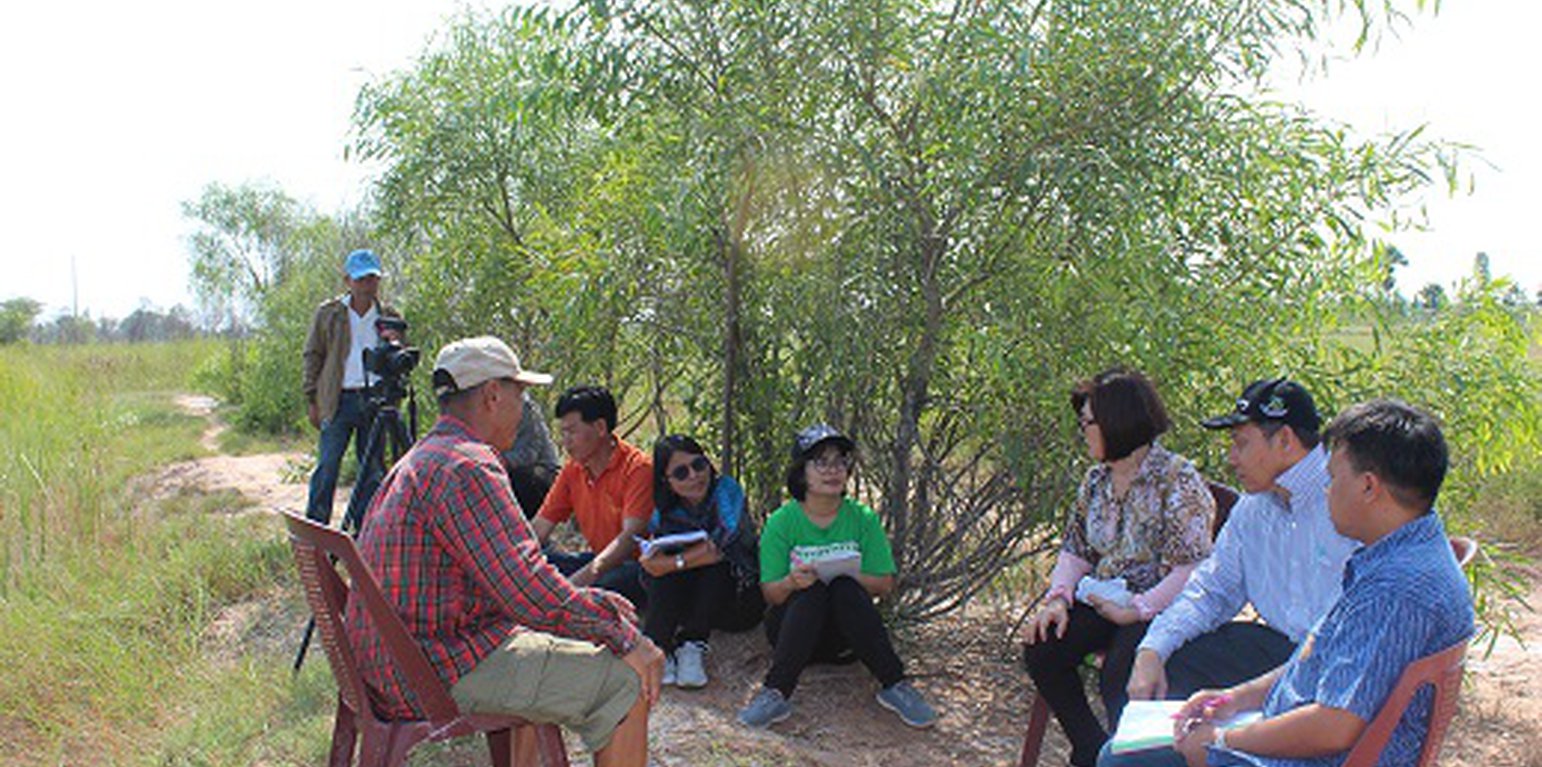Vegetative approach of using a halophyte ("Dixie grass", Sporobolus virginicus)) to rehabilitate severely salt-affected land.
(泰国)
描述
The government promotes a halophyte (Dixie grass) to control severely salt-affected land, rehabilitate the ecosystem and prevent the spread of salt in soil - with the cooperation of land owners, livestock farmers, the local administration, the local government agency, Land Development Department researchers and with specialists/ technical advisors in various fields.
The Ministry of Agriculture and Cooperatives through its Land Development Department (LDD) initiated a project on planting salt-tolerant trees and grasses on severely salt-affected land in the Northeast of Thailand in 1996. The project has facilitated the planting of a halophyte (a salt-loving plant), namely Sporobulus virginicus (Dixie grass) on salt-crusted and barren land. The main objectives of the approach has been to encourage land users to maximize their land area for farming, by preventing the formation of extensive severely saline soil. This is through planting Dixie grass as a cover crop to rehabilitate the land and ecosystem. The activities started with public meetings, then identifying severely salt-affected areas, and setting-up demonstration plots on farmers’ land to act as learning centers. There has also been communication with the local administration to call farmers’ meetings to develop detailed work plans and discuss strengths, weaknesses, opportunities, and threats of planting Dixie grass. The implementing activities consisted of 4 stages; PREPARATION was for seedling preparation, site selection of severely salt-affected soil and land preparation, public meetings and the establishment of the demonstration plot at Dan Chang Sub-district, Buayai District, Nakhon Ratchasima Province. COORDINATION included a joint meeting between farmers and researchers, joint monitoring & evaluation and follow-up and land users' decision-making. PLANTING started with selection of farmers joining the project, facilitating and training, a site visit to the model demonstration plot: this plot is the model for planting salt-tolerant trees and grasses on severely salt-affected land in the Northeast of Thailand. The final activity of SCALING-OUT occured when the land users/ farmers found that after 3 years of planting Dixie grass this barren land became covered by plants and much improved in biodiversity by the evidence of many varieties of wild grasses, flowers, dragonflies, small mammals and birds. Farmers could now grow rice and they used Dixie grass as feed for livestock. Moreover, and attractively, farmers were able to increase their incomes. Migration to big cities was reduced. The stakeholders were land owners, livestock farmers, the local administration, the local government agency, researchers and SLM specialists from LDD - and all worked together to mutual benefit. Nevertheless, although planting halophytes improves severely saline soil with low input costs, the recovery/accomplishment time (in saline soil improvement) cannot be as fast as that of engineering measures with much higher investment.
地点
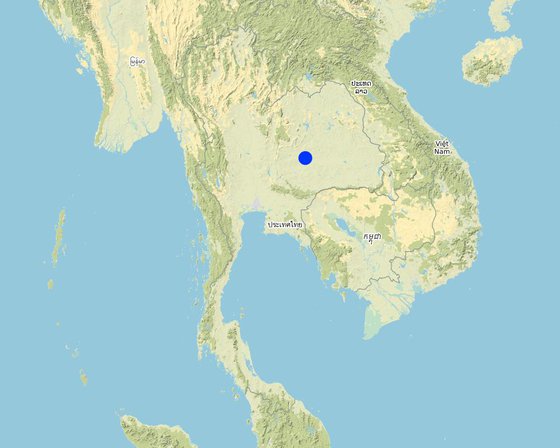
地点: 6 Ban Donpae Moo 8, Kut Chok Sub-district, Buayai District, Nakhon Ratchasima Province, 泰国
启动日期: 2015
终止年份: 2016
方法的类型
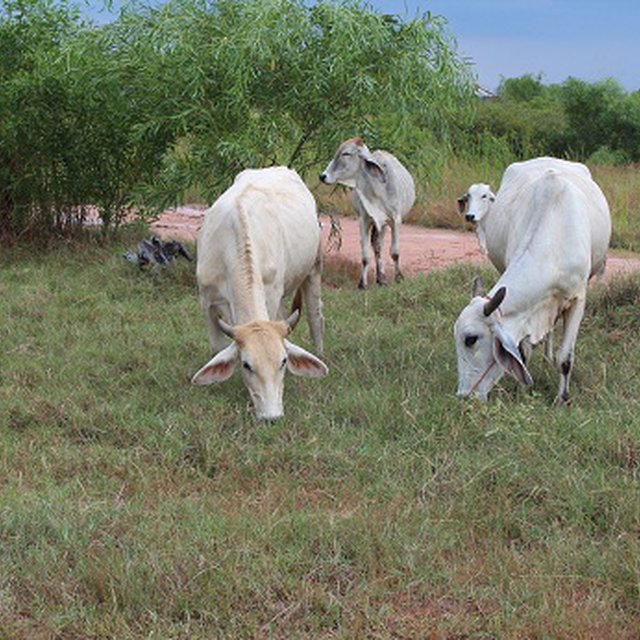
Dixie grass as pasture for cattle. (Kamontip Sasithorn)
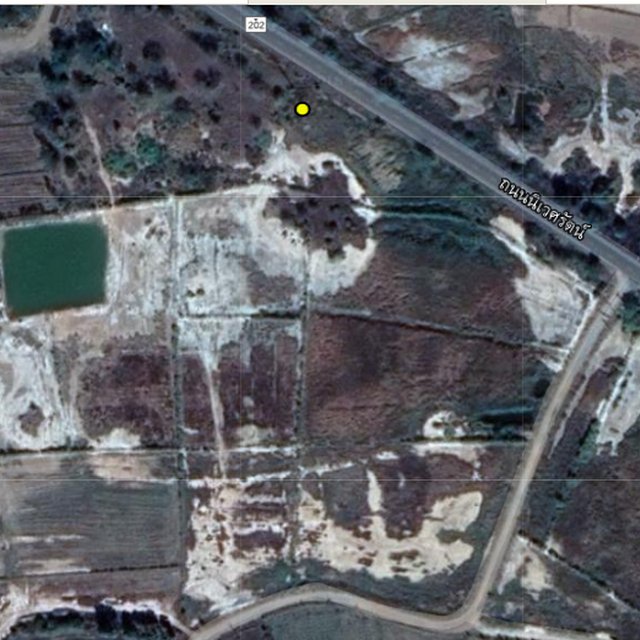
Selected sites for scaling-out planting Dixie grass on heavily salt-affected land. (Jutharat Rattanapunya)
方法目标和有利环境
该方法的主要目的/目标
The main objective of the approach was to enable and encourage land users to maximize land for farming, through preventing the formation of extensive severely saline soil, by the use of the halophyte, Dixie grass, as a cover crop.
推动实施本办法所应用技术的条件
-
社会/文化/宗教规范和价值观: The land users follow what their neighbours practice.
-
财务资源和服务的可用性/可得性: Through the Bank for Agriculture and Agricultural Cooperatives.
-
机构设置: Local administration
-
参与者的的协作/协调: Coordination of soil doctor volunteers and community leaders in the area.
-
政策: The government has a policy of preventing soil degradation.
-
了解SLM,获得技术支持: To provide knowledge to land users in the area.
-
工作量、人力资源可用性: For land users under the project
阻碍实施本办法所应用技术的条件
-
工作量、人力资源可用性: For land users outside the project
相关利益相关者的参与和角色
该方法涉及的利益相关者及其职责
| 该方法涉及哪些利益相关者/执行机构? |
指定利益相关者 |
说明利益相关者的角色 |
| 当地土地使用者/当地社区 |
Farmers under the project |
Planting halophytes (Sporobolus virginicus - Dixie grass) |
| 社区组织 |
Local administration (Sub-district Administration Organization) |
Call for meeting |
| SLM专家/农业顾问 |
Land Development Department |
Site selection |
| 研究人员 |
Land Development Department |
Provide technical recommendations |
| 国家政府(规划者、决策者) |
Land Development Department |
Funding, planner, decision-makers |
当地土地使用者/当地社区参与该方法的不同阶段
启动/动机
Land users in the project based
计划
Discussion with land users on work plan before starting the
activity.
实施
Land users/farmers in the project
监测/评估
Land users in the project
流程图
Four stages of participating process of technology development among organizations, community volunteers on soil improvement, farmers, SLM specialists and researchers.
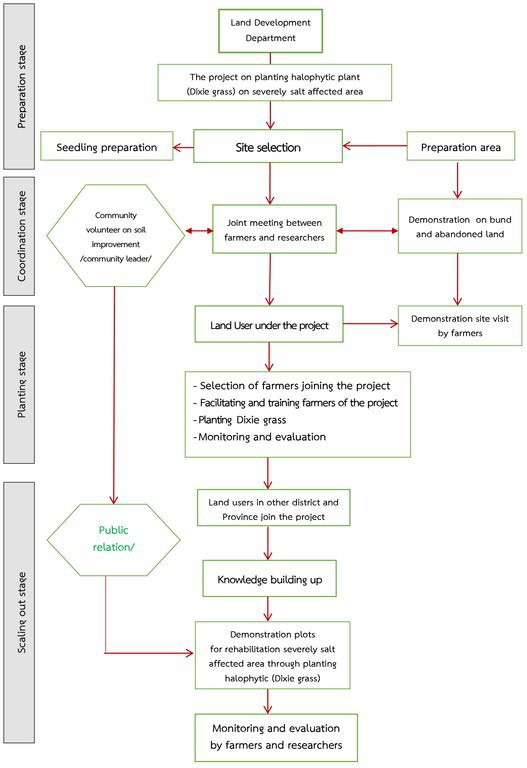
作者:Kamontip Sasithorn
有关SLM技术选择的决策
决策是由......做出的
-
仅限土地使用者(自主)
-
主要是土地使用者,由SLM专家提供支持
-
所有相关参与者,作为参与式方法的一部分
-
主要是SLM专家,咨询土地使用者之后
-
仅限SLM专家
-
政治家和领袖
决策是基于
-
对充分记录的SLM知识进行评估(基于证据的决策)
-
研究结果
-
个人经验和意见(无记录)
技术支持、能力建设和知识管理
以下活动或服务是该方法的一部分
-
能力建设/培训
-
咨询服务
-
机构强化(组织发展)
-
监测和评估
-
研究
能力建设/培训
涵盖的主题
Prevention and rehabilitation of salt-affected land with available technology and increased income for farmers.
咨询服务
1. Soil doctor volunteers represent the Land Development Department with a duty to provide knowledge to farmers in the area.
2. SLM specialists from Land Development Department visited and advised farmers in the area.
监测和评估
SLM specialists from Land Development Department collaborated with LDD soil doctor volunteers in surveying the survival rate and following up the growth of plants in the area.
研究
研究涉及以下主题
The Soil Salinity Research Group, LDD, conducted research on "halophytes plantation and the flow path along the landscape in Northeast Thailand" with Dr. J.L. Gallagher from Delaware Biotechnology Institute, University of Delaware.
融资和外部物质支持
SLM组成部分的年度预算,以美元计算
-
< 2,000
-
2,000-10,000
-
10,000-100,000
-
100,000-1,000,000
-
> 1,000,000
Precise annual budget: 不适用
Land Development Department
已向土地使用者提供以下服务或激励
-
为土地使用者提供财政/物质支援
-
特定投入的补贴
-
信用
-
其它激励或手段
为土地使用者提供财政/物质支援
Dixie grass planting material and land preparation cost
土地使用者的劳动力为
影响分析和结论性陈述
方法的影响
该方法是否有助于当地土地使用者,提高利益相关者的参与度?
Generate food security and family income.
这种方法是否有助于基于证据的决策?
Establish learning center for farmers as an information for technology adoption.
该方法是否帮助土地使用者实施和维护SLM技术?
Farmers well adopted the technology, resulting in the expansion of such Approach to a wider area.
该方法是否提高了土地使用者实施土地管理的知识和能力?
Farmers have adapted and changed SLM model to suit their own preference.
该方法是否改善了粮食安全/改善了营养?
Farmers can grow rice and they use Dixie grass as feed for livestock.
该方法是否会带来就业、收入机会?
The migration for job to big cities has reduced.
土地使用者实施SLM的主要动机
-
增加生产
-
增加利润(能力),提高成本效益比
-
减少土地退化
-
降低灾害风险
-
减少工作量
-
支付/补贴
-
规章制度(罚款)/执行
-
声望、社会压力/社会凝聚
-
加入运动/项目/团体/网络
-
环境意识
-
习俗和信仰,道德
-
提高SLM知识和技能
-
美学改进
-
冲突缓解
方法活动的可持续性
土地使用者能否维持通过该方法实施的措施(无外部支持的情况下)?
Farmers have better understanding and positive attitude of planting halophytes (e.g. Dixie grass). Moreover, they have more income generated from rice yield and livestock, as farmers can now grow rice and used Dixie grass to raise livestock.
结论和吸取的教训
长处: 土地使用者的观点
-
Soil doctor volunteer, local government agency and community leader were the coordinators in the area.
-
Farmers had easy access to markets and sources of Dixie grass cuttings.
-
Distribution of Dixie grass cuttings was done at no cost.
长处: 编制者或其他关键资源人员的观点
-
A supported technique created to make better environment on severely saline soil in the Northeast of Thailand.
-
Technique in planting Dixie grass was provided continually by Land Development Department and community volunteers on soil improvement.
-
A demonstrated plot was established in the area.
弱点/缺点/风险: 土地使用者的观点如何克服
-
Advertising of project was not extensive enough, particularly to the area of severely saline soil.
It is necessary for the Land Development Department to cooperate more closely with local administration to promote the project.
弱点/缺点/风险: 编制者或其他关键资源人员的观点如何克服
-
Some farmers did not believe that Dixie grass was very salt tolerant and will make the salinity of the soil decrease after planting it.
The officers should build up knowledge from successful farmers by frequently visiting farmers in the area under the project "rehabilitation of severely salt-affected soil by planting Dixie grass".
参考文献
审查者
-
Rima Mekdaschi Studer
-
Samran Sombatpanit
-
William Critchley
实施日期: Nov. 19, 2018
上次更新: Dec. 29, 2020
资源人
-
Somsak Yooburi - 土地使用者
-
Rungariam Sriwootpong - 土地使用者
-
Chiwat Auonpokang - Department of Agricultural Extension officer
-
Noorian Kumtisong - 土地使用者
-
Pirach Pongwichian (pirach.ldd@gmail.com) - SLM专业人员
-
Kamontip Sasithorn (misskamonthip@gmail.com) - SLM专业人员
-
Jutharat Rattanapunya (rattanapunya041206@gmail.com) - SLM专业人员
-
winai chombut (winai3898@gmail.com) - SLM专业人员
-
somsri arunin (ssarunin@gmail.com) - National consultant
文件编制者
机构
- Land Development Department LDD (Land Development Department LDD) - 泰国
项目
- Book project: where the land is greener - Case Studies and Analysis of Soil and Water Conservation Initiatives Worldwide (where the land is greener)
主要参考文献
-
Land Development Department: http://www.ldd.go.th/
